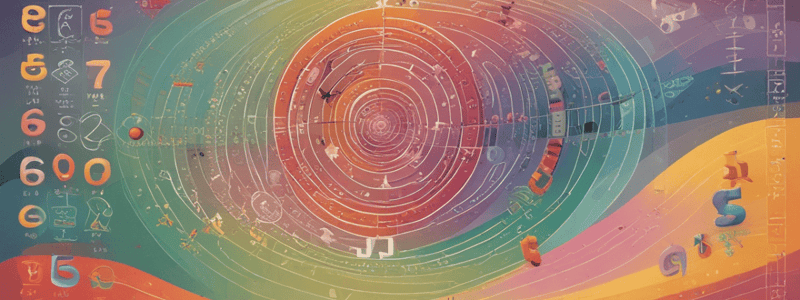Podcast
Questions and Answers
What is the set of numbers that includes fractions, decimals, and percentages?
What is the set of numbers that includes fractions, decimals, and percentages?
- Integers
- Rational Numbers (correct)
- Natural Numbers
- Real Numbers
What is the operation of finding the difference between two numbers?
What is the operation of finding the difference between two numbers?
- Division
- Multiplication
- Subtraction (correct)
- Addition
What is the graph of a relation between input and output values?
What is the graph of a relation between input and output values?
- Inequality
- Coordinate Plane
- Function (correct)
- Equation
What is the term for a set of points extending infinitely in two directions?
What is the term for a set of points extending infinitely in two directions?
What is the concept of approaching a value, but not reaching it?
What is the concept of approaching a value, but not reaching it?
What is the rate of change of a function?
What is the rate of change of a function?
Flashcards are hidden until you start studying
Study Notes
Numbers and Operations
- Number Systems:
- Natural Numbers (N): 1, 2, 3, ...
- Whole Numbers (W): 0, 1, 2, 3, ...
- Integers (Z): ..., -3, -2, -1, 0, 1, 2, 3, ...
- Rational Numbers (Q): fractions, decimals, percentages
- Irrational Numbers: non-repeating decimals, e.g. π, e
- Real Numbers (R): all rational and irrational numbers
- Operations:
- Addition (+): combining two or more numbers
- Subtraction (-): finding the difference between two numbers
- Multiplication (×): repeated addition
- Division (÷): sharing or grouping
- Exponents (^): repeated multiplication
- Roots (√): inverse operation of exponents
Algebra
- Variables and Expressions:
- Variables: letters or symbols representing unknown values
- Expressions: combinations of variables, constants, and operations
- Equations and Inequalities:
- Equations: statements with equal values, e.g. 2x + 3 = 5
- Inequalities: statements with unequal values, e.g. 2x - 4 > 0
- Graphing:
- Coordinate Plane: 2D grid with x-axis and y-axis
- Functions: relations between input (x) and output (y) values
Geometry
- Points, Lines, and Planes:
- Points: locations in space, represented by coordinates
- Lines: sets of points extending infinitely in two directions
- Planes: flat surfaces extending infinitely in all directions
- Angles and Measurements:
- Angles: formed by two rays sharing a vertex
- Degrees: units of measurement for angles
- Shapes and Solids:
- 2D Shapes: triangles, quadrilaterals, polygons, circles
- 3D Solids: cubes, spheres, pyramids, prisms
Calculus
- Limits:
- Concept of approaching a value, but not reaching it
- Derivatives:
- Rate of change, slope of a function
- Integrals:
- Accumulation of rates of change, area under a curve
Number Systems
- Natural Numbers (N): 1, 2, 3,...
- Whole Numbers (W): 0, 1, 2, 3,...
- Integers (Z): ..., -3, -2, -1, 0, 1, 2, 3,...
- Rational Numbers (Q): fractions, decimals, percentages
- Irrational Numbers: non-repeating decimals, e.g.π, e
- Real Numbers (R): all rational and irrational numbers
Operations
- Addition (+): combining two or more numbers
- Subtraction (-): finding the difference between two numbers
- Multiplication (×): repeated addition
- Division (÷): sharing or grouping
- Exponents (^): repeated multiplication
- Roots (√): inverse operation of exponents
Algebra
Variables and Expressions
- Variables: letters or symbols representing unknown values
- Expressions: combinations of variables, constants, and operations
Equations and Inequalities
- Equations: statements with equal values, e.g. 2x + 3 = 5
- Inequalities: statements with unequal values, e.g. 2x - 4 > 0
Graphing
- Coordinate Plane: 2D grid with x-axis and y-axis
- Functions: relations between input (x) and output (y) values
Geometry
Points, Lines, and Planes
- Points: locations in space, represented by coordinates
- Lines: sets of points extending infinitely in two directions
- Planes: flat surfaces extending infinitely in all directions
Angles and Measurements
- Angles: formed by two rays sharing a vertex
- Degrees: units of measurement for angles
Shapes and Solids
- 2D Shapes: triangles, quadrilaterals, polygons, circles
- 3D Solids: cubes, spheres, pyramids, prisms
Calculus
Limits
- Concept of approaching a value, but not reaching it
Derivatives
- Rate of change, slope of a function
Integrals
- Accumulation of rates of change, area under a curve
Studying That Suits You
Use AI to generate personalized quizzes and flashcards to suit your learning preferences.




